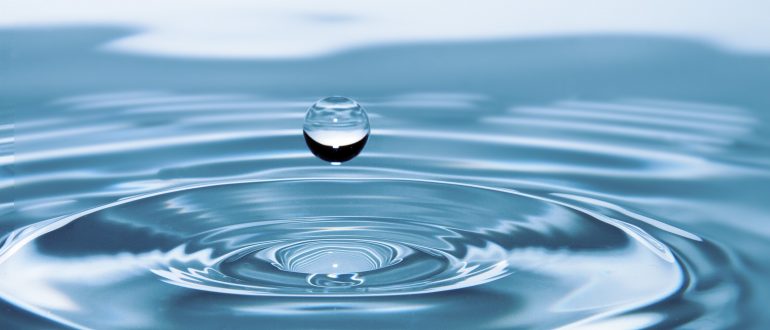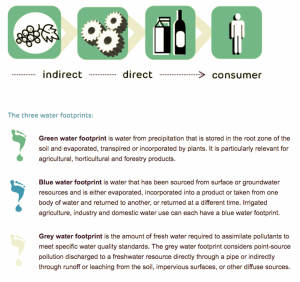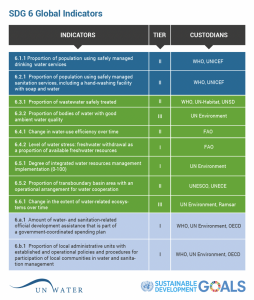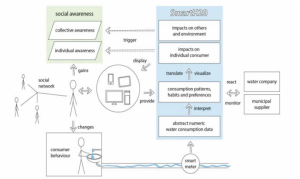
The Shape of Water

The following thematic paper presents the Sustainable Development Goal 6 and its targets as part of the United Nation’s Agenda 2030. A measurement to evaluate water quality and quantity is introduced, namely the so-called Water Footprint (WF) developed by the Water Footprint Network. Its composition is depicted and applied to the countries of the Latin America-Caribbean (LAC) region. Noteworthy is especially that a fifth of LAC’s WF is export driven. Due to the high degree in trade connections, most of the water is exported -virtually- to the European Union. Finally, we present innovative technological solutions to tackle climate change-related risks to drinking water supply on smart cities and the lack of clean water supply. One of the nature-based solutions mentioned is the protection of wetlands.
1.Introduction
This article’s title is not only coinciding with the title of the Oscar-winning movie by the Mexican director Guillermo del Toro, but also a crucial subject in the reality of the LAC region. This is reflected in the indigenous languages spoken on the continent: in Náhuatl there are 19 different translations of the word “water”, all depending on its shape. While asesek refers to cold water, itstikatl is iced water. Yaku is Quechua for water and was the essential claim within the Cochabamba Water conflict, a series of violent protests that took place in the third largest city of Bolivia in1999 and 2000. This conflict surged in response to an expected water price increase of more than 200 percent due to the privatization of the city’s municipal water supply company SEMAPA.[i] This is only one of numerous examples of conflicts related to the access, quality and supply of water in LAC.
In this paper, we tackle several water-related problems and find answers to the following questions: What are the global development goals with regard to water? How can water quality be measured efficiently? Furthermore, in our analysis we will give some concrete examples of technological innovations aiming at improving water quality and quantity.
2. The Water Situation in LAC
The Sustainable Development Goal (SDG) 6 aims at achieving universal access to safely and appropriately managed water resources as part of the 2030 Sustainable Development Agenda and includes monitoring framework with eight targets and eleven indicators.[ii] Access to safe water and sanitation as well as management of freshwater ecosystems are essential to human health and to environmental sustainability. To achieve SDG 6 by 2030, it is necessary to make investments in infrastructure and technologies and to provide sanitary facilities.
The LAC region has the highest coverage of drinking water in developing regions (94%). For example, in Uruguay more than 96 percent of the population has access to improved sanitation facilities, compared to less than half the population in Bolivia (46%) and almost a quarter (24%) in Haiti (2018 numbers). The countries with the least access to drinking water in LAC are: Haiti, Dominican Republic, Nicaragua, Ecuador, Peru and Bolivia.[iii]Since the 1990s, an extra of 35% of the population in LAC countries has gained access to improved sources of drinking water and in nearly all LAC economies at least 76 percent of the population uses improved sanitation according to the United Nations definitions. [iv] The only exceptions are Bolivia, Panama, Nicaragua, El Salvador and Guatemala.
For a long time, the world has first turned to build man-made infrastructure – also known as gray infrastructure – to improve the management of water resources. In doing so, it has often neglected traditional and indigenous knowledge, which adopts more ecological approaches. In consideration of the Agenda 2030, there are many nature-based solutions to contribute to the achievement of the water management objectives like the ones mentioned below.
2.1. Water Quality Measurement
Referring to the title of this paper, water can also take the shape of a footprint – the water footprint (WF) developed by the Water Footprint Network is one common concept of making its consumption comparable. It measures the amount of water used to produce each of the goods and services we use. It can be measured for a single process such as growing rice, for a product such as a pair of jeans, or for an entire (multi-national) company. The water footprint can also tell us how much water is being consumed by a particular country – or globally – in a specific river basin or from an aquifer.[v]
Figure 1: Components of the agricultural water footprint: green, blue and grey (from SAB Miller and WWF, 2009)

The total WF of production in LAC in the period between 1996 and 2005 was 1,162 billion m3/y (87% green, 5% blue and 8% grey). Crop production contributed 71percent, followed by grazing (23%). Maize and the globally risen demand for soybeans contributed 18percent each to the crop-related WF. About 21percent of the WF within LAC is related to production for export.[vi] About 78percent of this total virtual water export is related to export of soybeans, coffee, cotton, livestock products and sugarcane. Most of the virtual water export was destined to the EU (36%), the US (22%) and China (8%).[vii]
2.2. Betting on Ecological Engineering
The use of “green” infrastructures as opposed to “gray” infrastructures which is used to improve water management relies on ecological engineering, which preserves the ecosystems. As water demand continues to rise, countries and municipalities are increasingly interested in green solutions. The green solutions are essential for the achievement of the SDG 6. An example of nature-based solutions are wetlands, which cover only 2.6 percent of the planet but play a leading hydrological role: they have a direct impact on water quality and act as filters to retain some toxic substances derived from pesticides, industrial waste or water. It is estimated that wetlands can by themselves remove between 20 and60 percentof the metals contained in the water and retain between 80 and 90 percent of the sediments of runoff waters. Wetlands also act as natural barriers and sponges that capture rainwater, which limits soil erosion and the impact of certain natural catastrophes, such as floods. Despite all these benefits, there is still very little recourse to nature-based solutions. Most of the current investments continue to be concentrated on “gray” infrastructures.[viii]
2.3. Targets of the SDG 6
The SDG 6 is one of 17 Goals agreed upon by the United Nations in September 2015.[ix]The SDG 6 are monitored by eleven indicators, which are divided into three groups – so-called Tiers – depending on data availability and maturity of measurement.[x] The indicators are shown in Figure 2. Tier I indicators thereby count with an approved methodology and can be tracked by data which come from countries itself. rather than from international agencies.
Figure 2: SDG 6 Global Indicators. Retrieved from: http://www.unwater.org/publications/sdg-6-indicators-tiering-system/

2.4. Co-Operation in Achieving the SDG 6
Besides investment in infrastructure and all kinds of material support, more international cooperation in knowledge and immaterial values is needed to encourage water efficiency and support treatment technologies in developing countries. In 2018, a new environmental development program with a regional focus on LAC, funded by the European Commission was put into practice: The EUROCLIMA+ program seeks to support LAC in achieving their self-chosen environmental goals formulated in the 2015 Paris Climate Agreement. The importance of water management for climate change adaptation has also been highlighted in the “Paris Agreement on water and climate change adaptation of hydrographic basins, lakes and aquifers” that was presented at the 2015 United Nations Climate Change Conference (COP21). The program intervenes in the realm of water management in the context of urban resilience – due to the fact that Central and South America are the regions with the highest rate of urban population (80.4%, which continues to grow), behind North America (81.6%) and significantly above the world average (United Nations, 2014).
3. Innovations and Opportunities
Currently, many countries face problems such as climate change or deterioration of gray infrastructure systems. Because of these problems, the populations suffer from inefficient management and increasing scarcity of water resources, as well as of decreasing water quality. Intervention is necessary through innovative technologies that guarantee the optimization of resources and costs. The introduction of innovative technologies has much potential to assist in reaching the SDG6.
An effort underway is a range of innovative, low-cost technologies called SMART (Simple, Market-based, Affordable, Repairable Technologies). Examples are manual drilling, locally produced hand pumps, tube groundwater recharge to store rainwater in the ground, household water filters, and others. An example of an innovative technology that seeks to improve access to water for all are the fog catchers or collectors. These are vast mesh nets that capture moisture from fog, which drips into collection trays after condensation. The water is clean, free and instant. An initiative to collect moisture from the sea haze in Lima has become an inventive and profitable solution to the growing water shortage in the Peruvian capital. Fog collecting projects have also been implemented in countries such as Chile and Guatemala.
Smart cities and water
Cities are complex and water is only one of many topics that need to be taken into account in promoting inclusive, safe, resilient and sustainable urbanization. Nevertheless, sound water management provides the foundation for all aspects of sustainable urban development and therefore needs to be adequately reflected in the frameworks like the SDG 6.
In line with the “Europe 2020” strategy, the European Commission proposed different actions to create a “resource-efficient” Europe and promote awareness on the sustainable use of water resources. In this strategy, it has developed an information communications technology (ICT) platform, called SmartH2O. The SmartH2O project wants to deliver a) platform to provide support for water utilities in determining optimal water pricing as well as to consumers in changing their water consumption habits, while at the same time contributing to a more efficient use of water. This is done with the integration of smart metering, social computation, dynamic water pricing, and consumer behavioral models. Furthermore, the SmartH2O project stresses the importance of innovation in the water sector by coupling smart meter technologies with innovative end-user services which could help realize better water management. [xi]
Figure 3: The flow of information of the SmartH2O platform. Retrieved from http://smarth2o.deib.polimi.it/

4. Conclusions and Outlook
In order to counteract new challenges related to water security posed by population growth and climate change, we need new water resources management solutions. If we do not act now, around 5,000 million people will live in areas with water shortages by 2030. Preventing conflicts related to water is a great challenge which has to be faced together and in a responsible way. Improvement in agricultural practices and water management must come along with technical support to small farmers, engagement of river basin managers and policy makers, and high-quality data at the river basin level. Mechanisms need to be adopted that constrain the exploitation of land and water resources within environmental thresholds in accordance with the Paris Agreement and agricultural practices need to be developed that lead to more value in accordance with the SMART principles. Since a noteworthy amount of water in LAC economies is used for producing export goods, it has to be monitored how and if this amount increases with the growing commercial interaction between LAC and the EU (e.g. modernized EU-Mexico Global Agreement in April 2018).
In short, the water problem does not have a solution, it has many. As the means to carry them out are limited, it is necessary to plan the measures to be developed. Creating an enabling environment that contributes to inclusive and informed decision-making, and the planning of water resource management, are a top priority. This will be possible through coherent policies, legal frameworks, dedicated financing, strong institutions and partnership with, and involvement of, all relevant stakeholders in society.
References
[i] Crane Draper, M. and Shultz, J. (2008): Dignity and Defiance. Stories from Bolivia’s challenge to globalization. University of California Press, Los Angeles.
[ii] United Nations Sustainable Development Knowledge Platform 2017. Sustainable Development Goal 6: Ensure availability and sustainable management of water and sanitation for all. Accessed March 2018.
[iii]CASMA,Julio C. América Latina: la región con más agua, la más castigada por la sed. Peru, Lima. 13 May 2015. Retrieved from: https://elpais.com/internacional/2015/05/13/actualidad/1431542093_232345.html.
[iv] World Health Organization: Progress on Sanitation and Drinking Water: 2015 Update and MDG Assessment.
[v] Aldaya, M., Chapagain, A., Hoekstra, A., Mekonnen, M. (2011): The Water Footprint Assessment Manual: Setting the Global Standard. Published by Taylor & Francis, New York.
[vi] UNESCO Institute for Water Education (2014): Water Footprint assessment for Latin America and the Caribbean: An Analysis of the Sustainability, Efficiency and Equitability of Water Consumption and Pollution. In: Value of Water Research Report Series No. 66.
[vii] ibid.
[viii] WWAP Presentation: Launch of the UN World Water Development Report 2018.
[ix] UNDP 2016; Retrieved from: http://www.undp.org/content/undp/en/home/sustainable-development-goals.html
[x] Retrieved from: http://www.unwater.org/publications/sdg-6-indicators-tiering-system/.
[xi] Novak, J., Melenhorst, M., Micheel, I., Pasini, C., Fraternali, P., Rizzoli, A.E., (2016), Behaviour change and incentive modelling for water saving: first experiences from the SmartH2O project. Proceedings of the 8th International Congress on Environmental Modelling and Software – iEMSs 2016, Toulouse (France).

Jennyfer Pais (Guatemala) and Hannah Redders (Germany)
Jennyfer Pais holds a Master's degree in Sanitary Engineering at the Regional School of Sanitary Engineering (ERIS) of Central America and gained work experience at a research center in Guatemala City, where she focused on chemical, environmental and social projects. Prior to this, she graduated with a B achelor’ s degree in Chemical Engineering from the University of San Carlos of Guatemala; and took different courses in Costa Rica, Uruguay and Spain. She wrote her bachelor thesis in a leading construction materials company in the region, with the topic of cement and nanotechnology. Hannah Redders currently studies a double degree MSc in Development Economics at the University of Goettingen and the University of Stellenbosch, South Africa. She works with small-scale farmers researching the effect of climate change on socio-economic aspects in Limpopo, South Africa for a bi-national research project funded by the German government. Her academic interest is directed to better understand the drivers and patterns of inequality. Already in her Bachelor’s thesis she applied an inequality of opportunities framework to education in Mexico, obtaining her degree in Economics and Latin American Studies at the University of Passau. Hannah interned at the German Embassy in Bogotá, Colombia and volunteered in Mexico.
